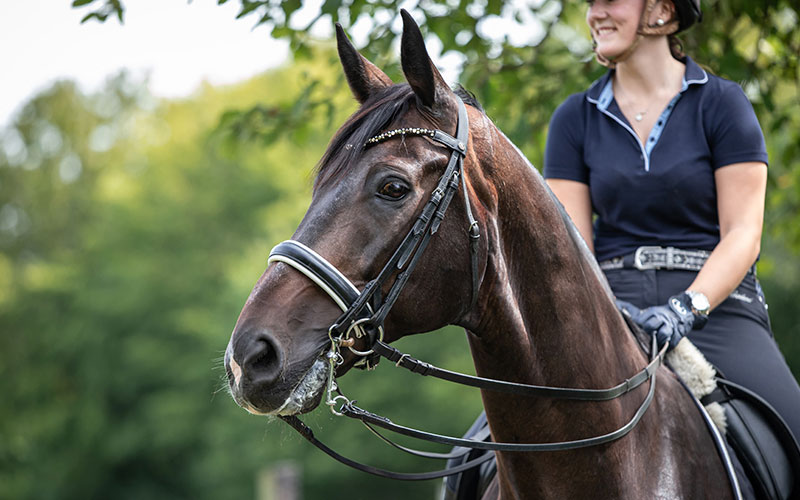
Für die feinen Lektionen
Kandarengebisse
Kandaren Gebisse werden zumeist nur in der höheren Dressur genutzt und dient der Verfeinerung der Hilfen in höheren Lektionen. Sie werden in der Regel in Kombination mit einer Unterlegtrense genutzt.
Bitte beachte, dass wir auf Zerbiss keine Gewährleistung geben. Bitte teste das Gebiss nicht im Pferdemaul wenn du dir bei der Größe unsicher bist, da wir Gebisse mit Kratzspuren nicht zurück nehmen können.
- Super Sale -70%
-
For you
- Riding breeches
- Riding helmets
- Tournament
- Clothing
- Shoes & Boots
- Accessories
- Tools & safety
- Gifts
- Hobby Horse
- For your horse
- Riding helmets
- Collections
- Tournament
- Dog
- Brands
- SALE
- Knowledge
Nur für feine Hände
Kandarengebiss
Das Kandarengebiss ist eine ungebrochene Stange, mit oder ohne Zungenfreiheit, welche 1/2 bis 1 cm kleiner gewählt werden sollte, als die Unterlegtrense. Rechts und links der Stange, außerhalb des Pferdemauls, sind die sogenannten Bäume. Wichtig ist, dass die Seitenteile der Kandare dicht an den Maulwinkeln abschließen. Ist zu viel Spiel zwischen Maulwinkel und Seitenteilen, kann die Kandare blockieren und im Extremfall verkanten. Die Kinnkette verstärkt die Hebelwirkung und sorgt für Druck auf den Unterkiefer.
Aus diesen Gründen gehört die Kandare und das Kandarengebiss nur in erfahrene, ruhige Reiterhände. Komplettiert wird die Kandare durch eine Unterlegtrense, auf der hauptsächlich geritten wird. Das Kandarengebiss wird nur zur Verfeinerung der Hilfen eingesetzt, weshalb die Zügel in der Regel etwas durchhängen.
Types of curb bits
Dressage curb bit / French curb bit
French or dressage curb bits are available with short or long shanks, usually 5 cm or 7 cm. Curb bits with short shanks are also called baby curbs. However, this does not mean that this type is "softer". Of course, there is less leverage due to the short bit, but the rein aids reach the horse's mouth much faster. With a long rein, there is a little more leeway and you can adjust the pressure in finer increments. Remember: the longer the rein, the smaller the angle of attack that results from a certain shortening of the rein. This means that the "baby" curb bit works much faster and therefore more sharply for the same amount of rein. Basically, you now need to consider whether your hand is fine enough to work in millimetres and whether your horse needs direct, clear aids or a little more time to think.
Double bridle bits with tongue free
The French curb bit differs from the standard dressage curb bit only in the shape of the bar. This is a bar that is only slightly bent upwards without tongue freedom. All other curb bits have little to a lot of tongue freedom. Tongue freedom is a controversial issue nowadays. The more tongue freedom the bit offers, the sharper the effect of the curb bit. In addition, the horse's mouth must offer enough space, otherwise the curvature will press on the palate. According to the latest findings, the tongue tends to be pinched by the freedom of the tongue and the horse does not have the opportunity to push the bit upwards with its tongue to counteract too much pressure. If the bar is only slightly curved, it acts evenly on the entire tongue when pressure is applied on the same side. However, if there is too much pressure on one side, there is a risk of canting.
Post curb bits / Liverpool curb bits
The broken curb bits, also known as driving curb bits, post curb bits or Liverpool curb bits, are an exception. They are used without a snaffle bit. Driving curbs have up to three "eyelets" one below the other, into which the driving line can be buckled. Frequently used are post curbs with two eyelets, which together have the shape of a "B". The deeper the driving line is buckled in, the sharper the curb bit is.
Welches Kandarengebiss denn nun?
Welches Kandarengebiss du nutzen möchtest, hängt also von vielen Faktoren ab. Sind du und dein Pferd in der Ausbildung so weit fortgeschritten, dass ihr die sogenannte "Kandarenreife" bereits erlangt habt? Wie viel Platz steht im Pferdemaul zur Verfügung? Beobachte die Reaktionen deines Pferdes auf das jeweilige Gebiss ganz genau und finde so heraus, welches Kandarengebiss dein Pferd bevorzugt.


























